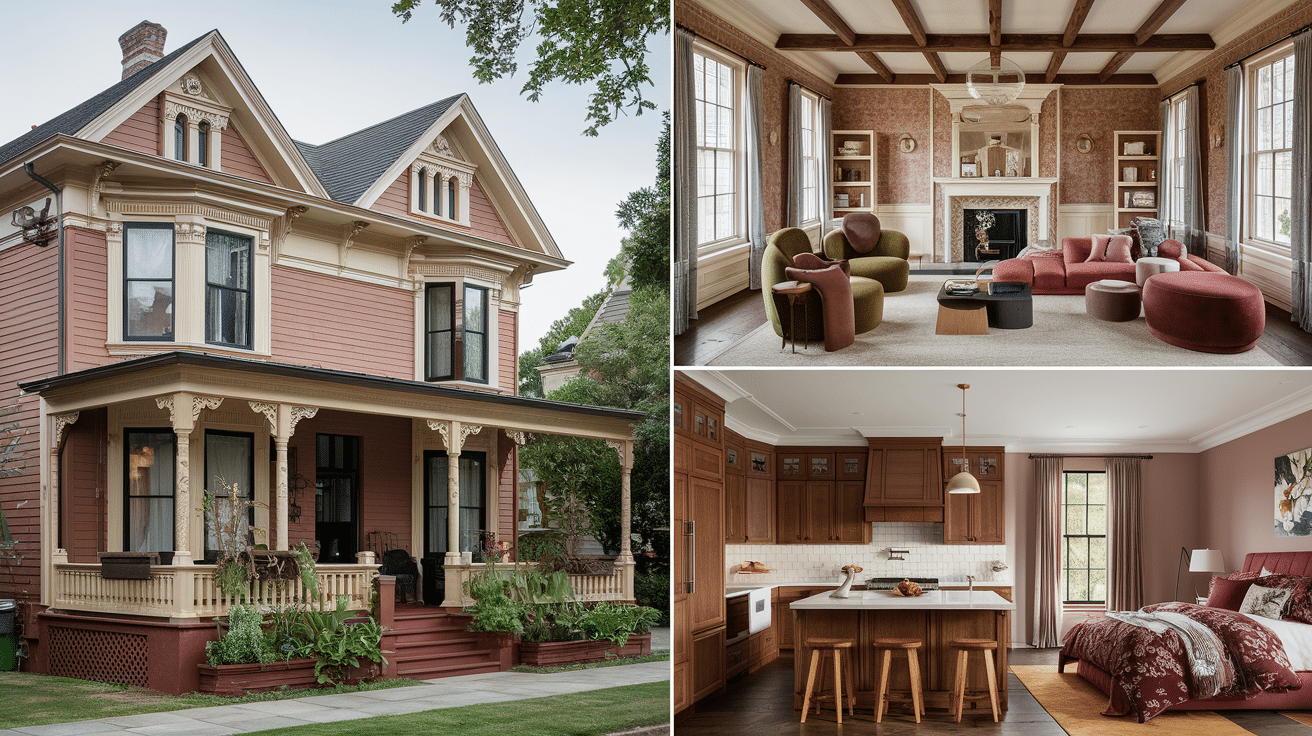Imagine a home that carries the charm of the past but functions with the ease of the future. Welcome to the world of Modern Victorian Homes.
These remarkable dwellings represent a masterful blend of 19th-century architectural grandeur and 21st-century convenience.
Modern Victorian houses have evolved beyond mere preservation. They showcase how historic charm can seamlessly integrate with contemporary living.
Swooping staircases and traditional bay windows coexist with open-concept kitchens and updated floor plans.
This thoughtful fusion creates homes that honor their architectural heritage while embracing the needs of today’s families.
What is a Modern Victorian House?
A Modern Victorian House represents the perfect marriage of historical grandeur and contemporary innovation.
These architectural treasures began their story as classic Victorian homes—built during Queen Victoria’s reign (1837-1901)—but have been thoughtfully transformed to meet today’s lifestyle demands.
At their core, these dwellings maintain signature Victorian features like ornate woodwork, steep-pitched roofs, and decorated gables while embracing modern upgrades that enhance livability.
Victorian charm seamlessly blends with modern updates—preserving period details while creating open spaces and discreetly incorporating new technology behind vintage-inspired elements.
This thoughtful evolution proves that Victorian architecture can adapt beautifully to modern life without losing its soul.
The History of Modern Victorian Houses
The modern Victorian house emerged as a distinct architectural movement in the late 20th century.
It represents a revival and reinterpretation of the original Victorian architectural styles, which dominated from 1837 to 1901 during Queen Victoria’s reign.
Ornate detailing, asymmetrical shapes, steep rooflines, towers and turrets, decorative trim, and bold color schemes characterized the original Victorian homes.
These homes were products of the Industrial Revolution, which allowed for mass production of architectural elements previously only available to the wealthy.
The modern Victorian movement gained momentum in the 1970s and 1980s as a reaction against minimalist modernism.
Key Features of a Modern Victorian Home
- Architectural Elements: Dramatic 10-14 foot ceilings create instant grandeur. Hand-carved trim and curved bay windows maintain historic character, while restored fireplaces are stunning centerpieces in modern living spaces.
- Interior Design Blend: Original crown moldings and ceiling medallions pair with sleek furniture. Historic wainscoting frames contemporary art, and restored architectural details complement updated room layouts.
- Color Palettes: Jewel tones (emerald, sapphire, garnet) mix seamlessly with modern neutrals like gray and taupe. This balanced palette highlights period features while keeping spaces fresh and current.
- Furniture Choices: Modern velvet sofas and clean-lined wooden tables complement original hardwood floors and vintage lighting. Each piece balances comfort with historic charm.
- Smart Home Integration: Modern tech hides behind period details. Wireless speakers nestle in ceiling medallions, vintage-style switches control smart lighting, and security features blend with decorative trim.
Why Homeowners Love Modern Victorian Homes?
The magic of a Modern Victorian lies in its perfect blend of historical elegance and modern comfort.
Original features like ornate trim work and dramatic staircases harmonize with updated kitchens and energy-efficient systems, creating homes that honor their heritage while embracing contemporary living.
These homes strike an impressive balance – soaring ceilings and grand entryways provide elegance, while thoughtfully updated floor plans create cozy family spaces.
Unlike their historical counterparts, Modern Victorians blend formal areas with casual living spaces that suit today’s lifestyle.
Five Types of Modern Victorian Houses
Modern Victorian houses come in diverse styles, each offering a unique interpretation of this beloved architectural tradition, understand these different approaches can help you identify which modern Victorian style resonates most with your taste and lifestyle.
1. The Classic Restored Victorian
These meticulously preserved homes maintain authentic Victorian bones while subtly incorporating modern necessities.
Original architectural treasures remain intact—elaborate trim work, intricate staircases, and decorative ceiling medallions.
At the same time, outdated systems are replaced with state-of-the-art alternatives hidden behind walls and under floors.
The result is a living time capsule that offers historical immersion and modern comfort—proving that respecting a home’s heritage doesn’t mean sacrificing today’s conveniences.
Key Features:
- Original architectural elements, including period moldings and fireplaces
- Modern kitchen and bathroom updates that complement historical features
- Historically accurate color schemes with contemporary sophistication
2. The Minimalist Modern Victorian
The Modern Victorian aesthetic blends historical charm with contemporary minimalism, preserving period character while eliminating excessive ornamentation to create cleaner, more functional spaces.
This thoughtful fusion creates interiors that feel simultaneously timeless and fresh, with rich architectural details that don’t overwhelm the senses.
The result is a balanced style that honors Victorian roots while perfectly suiting modern sensibilities—spaces that tell stories of the past while meeting present-day needs for simplicity and function.
Key Features:
- Simplified Victorian silhouettes with monochromatic color schemes
- Traditional ornate details paired with minimal, modern furnishings
- Seamlessly integrated smart home technology and contemporary lighting
3. The Eclectic Victorian Revival
This bold approach embraces Victorian exuberance while incorporating sleek contemporary elements.
It celebrates decorative excess through a modern lens, creating playful and sophisticated spaces.
This creative fusion pairs ornate period details with clean-lined furniture and unexpected colors, resulting in dramatic interiors that honor tradition while breaking design rules.
The style offers a refreshing alternative to minimalism, proving that more can be more when executed with intention and confidence.
Key Features:
- Rich colors and patterns mixing Victorian and modern design elements
- A blend of vintage architectural details with contemporary artwork and decor
- Statement lighting and fixtures that bridge traditional and modern styles
4. The Industrial Victorian
It celebrates the structural integrity of both eras, pairing elaborate Victorian moldings with visible ductwork and industrial fixtures for dramatic contrast.
The approach honors craftsmanship from different periods, allowing vintage architectural features to coexist with modern industrial materials in perfect tension.
This harmonious clash of elegant and utilitarian creates uniquely characterful interiors that tell stories of 19th-century grandeur and industrial practicality.
Key Features:
- Exposed original materials paired with modern industrial elements
- Open-concept layouts that maintain Victorian architectural details
- Contemporary industrial lighting contrasting with traditional features
5. The Contemporary Victorian Cottage
This charming approach reimagines Victorian elements more intimately, creating cozy, livable spaces that balance historic character with modern comfort.
It softens traditional Victorian formality with relaxed furnishings, lighter color palettes, and simplified architectural details, maintaining period authenticity without overwhelming smaller spaces.
The style emphasizes practical luxury—incorporating contemporary conveniences and comfortable layouts while preserving the handcrafted details and unique character that make Victorian cottages appealing
Key Features:
- Soft color palettes blending Victorian and contemporary design
- Modern, open layouts while preserving traditional cottage elements
- Updated fixtures and finishes that complement original features
How to Infuse Victorian Style into Non-Victorian Homes
Love Victorian aesthetics but live in a completely different style of home?
You don’t need to move or undertake a massive renovation to bring Victorian charm into your space.
With some strategic design choices, you can create a Victorian-inspired atmosphere in virtually any home.
Making a Mid-Century Home Feel Victorian
Mid-century modern and Victorian styles might seem complete opposites, but they can complement each other surprisingly. Here’s how to add Victorian touches to your mid-century home:
Architectural Elements
- Install decorative crown molding in key rooms (living room, dining room)
- Add picture rail molding to highlight wall art
- Replace plain doorknobs with ornate brass or crystal options
- Install ceiling medallions around light fixtures
Furniture and Layout
- Incorporate one statement Victorian piece (a velvet settee or carved armchair) as a focal point.
- Create intimate conversation areas instead of the typical open mid-century layout.
- Add a Victorian-inspired room divider or folding screen to break up open spaces.
- Use side tables with curved legs and marble tops alongside mid-century pieces.
Temporary Architectural Details
- Use peel-and-stick wallpaper in Victorian patterns (damask, floral, or William Morris designs)
- Install removable picture rail molding
- Add decorative corner moldings with removable adhesive
- Hang Victorian-style mirrors to create the illusion of architectural detail
Conclusion
Walking into a modern Victorian home feels like stepping through time.
These homes tell stories through their distinctive trim work, high ceilings, and unique shapes.
Yet behind their historical appearance, they hide modern comforts—efficient heating, updated kitchens, and open living areas that work for today’s families.
These homes offer an ideal balance for those who value history and comfort.
You can enjoy the character of yesteryear without giving up the conveniences we’ve come to expect.
In these special spaces, the old and new come together naturally.















